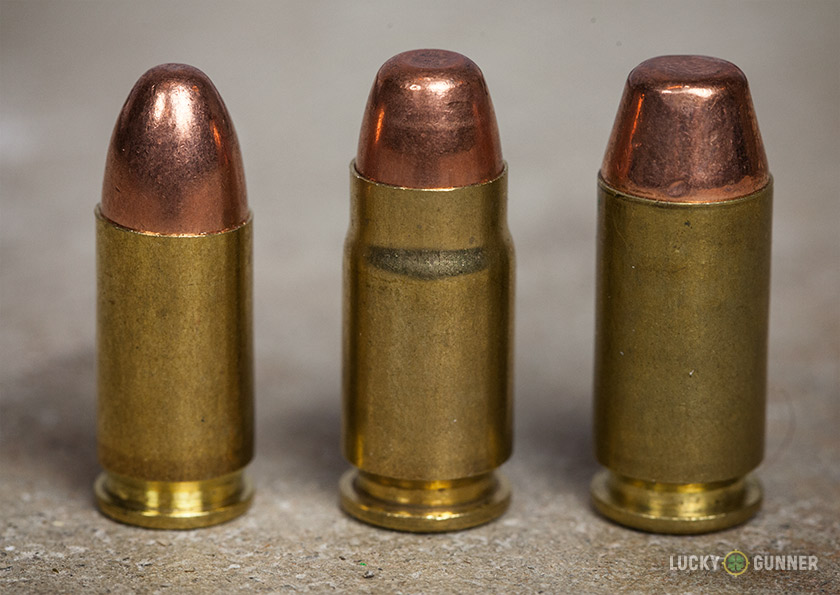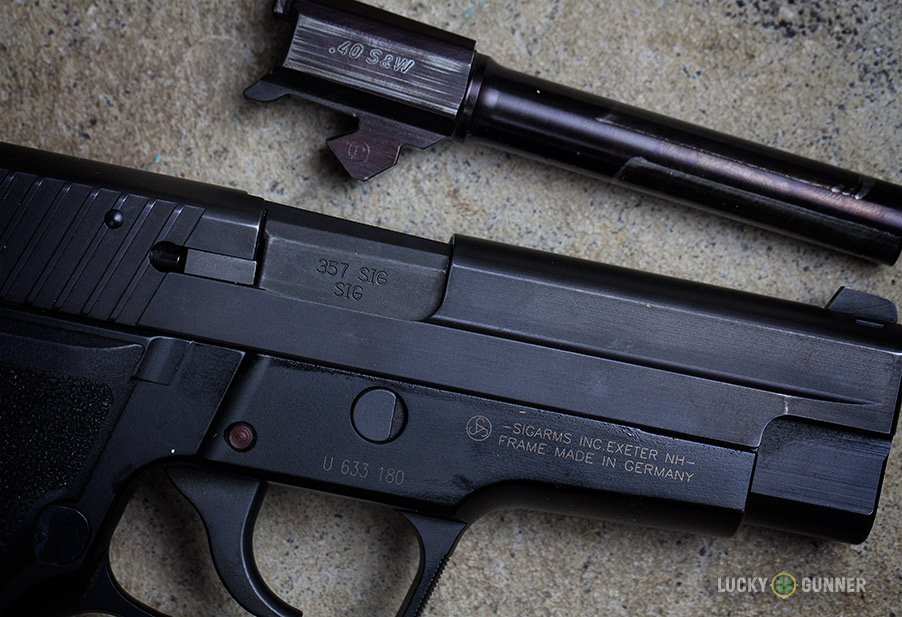A little review here I thought was pretty good on the 3 of these. Nothing to do with the 38 but puts these in perspective.
http://www.linkedin.com/shareArticl.../www.luckygunner.com/lounge/happened-357-sig/
With Sig Sauer’s new line of self-defense ammo just hitting the market, I thought now would be an appropriate time to take a look back at Sig’s last major impact on the ammo industry: the .357 Sig.
First introduced in 1994, the debut of the .357 Sig caliber trailed the initial production of .40 S&W by four years. Twenty years later, .40 S&W is in a comfortable spot as one of the top three most popular centerfire handgun calibers in the country and .357 Sig lags far behind, with no signs of it catching up.
Stranger things have been known to happen in this industry, so I won’t make any bold proclamations about this cartridge having no hope of ever displacing one of the “big three”, but let’s just say things aren’t looking too good for .357 Sig. If it didn’t gain mainstream popularity in 20 years, the chances of it suddenly being embraced by civilians and law enforcement are slim.

Left to right: 9mm, .357 Sig, .40 S&W. The .357 Sig uses a .40 S&W case necked-down to use a 9mm diameter projectile.
So what happened? It’s not as if .357 Sig was some wildcat cartridge developed in a garage and sold in sketchy classifieds in the back pages of gun rags. Sig is a major firearms company with a lot of smart people working behind the scenes and a plethora of resources. Shortly after the .357 Sig’s release, a few major state-level law enforcement agencies thought the round had enough promise to adopt it for all of their officer’s duty weapons. Reviews of its performance were mostly positive, but it still failed to catch on. So why not?
I don’t claim to have it all figured out, but there are a few contributing factors that seem pretty obvious:

With a simple barrel swap, many pistols can be converted from .40 S&W to .357 Sig vice versa. Most even use the same magazines for both calibers as well.
I have no doubt that some agencies and individuals will continue to stand by .357 Sig for many years, and they will probably be well-served by the cartridge. It’s a good caliber with a solid reputation and performance history. Pistols using the cartridge might need more frequent spring replacement, but otherwise, they should continue to work as well as any other guns. As an added benefit, converting these guns to .40 S&W, and even 9mm, is usually incredibly easy and affordable. But I really doubt we’ll see many new pistols in this caliber any time soon (other than perhaps from Sig Sauer), and ammo is unlikely to be as prevalent as the other popular calibers.
http://www.linkedin.com/shareArticl.../www.luckygunner.com/lounge/happened-357-sig/
With Sig Sauer’s new line of self-defense ammo just hitting the market, I thought now would be an appropriate time to take a look back at Sig’s last major impact on the ammo industry: the .357 Sig.
First introduced in 1994, the debut of the .357 Sig caliber trailed the initial production of .40 S&W by four years. Twenty years later, .40 S&W is in a comfortable spot as one of the top three most popular centerfire handgun calibers in the country and .357 Sig lags far behind, with no signs of it catching up.
Stranger things have been known to happen in this industry, so I won’t make any bold proclamations about this cartridge having no hope of ever displacing one of the “big three”, but let’s just say things aren’t looking too good for .357 Sig. If it didn’t gain mainstream popularity in 20 years, the chances of it suddenly being embraced by civilians and law enforcement are slim.

Left to right: 9mm, .357 Sig, .40 S&W. The .357 Sig uses a .40 S&W case necked-down to use a 9mm diameter projectile.
So what happened? It’s not as if .357 Sig was some wildcat cartridge developed in a garage and sold in sketchy classifieds in the back pages of gun rags. Sig is a major firearms company with a lot of smart people working behind the scenes and a plethora of resources. Shortly after the .357 Sig’s release, a few major state-level law enforcement agencies thought the round had enough promise to adopt it for all of their officer’s duty weapons. Reviews of its performance were mostly positive, but it still failed to catch on. So why not?
I don’t claim to have it all figured out, but there are a few contributing factors that seem pretty obvious:
- Almost all new handgun cartridges fail to catch on. The market for rifle cartridges is a little different, but for handguns, it’s almost impossible to start from scratch and get a new cartridge to catch on. The most popular handgun calibers are almost all 100 years old, and the top two (9mm and .45 ACP) have been used by our own military, boosting both their popularity and availability. The newest handgun cartridge that could be considered mainstream is .40 S&W, and I don’t think the market could handle more than one exception to the rule in such a short time period. So from the very start, it was an uphill battle for the .357 Sig.
- When a new handgun cartridge does “make it big”, its success can almost always be tied back to its adoption by law enforcement. That seems to have been Sig’s goal from the beginning, and they did see some success. But they were up against the giant Glock marketing machine, which was in its prime in the 1990s. Glock not only convinced scores of police departments to switch from their beloved All-American steel and wood revolvers to Glock’s new fangled plastic space Euro-guns, they also went back to those same departments a few years later and got them to all upgrade those 9mm Glocks to .40 S&W versions at virtually no additional cost. This is what Sig was up against in the effort to attract business from law enforcement, and it’s no wonder they came up short.
- I think marketing and hype have a lot more to do with a cartridge’s success than its actual performance, but it certainly helps if you can demonstrate some performance gains when putting together that marketing strategy. The ballistics for .357 Sig are certainly not bad by any stretch, but they’re not appreciably better than .40 S&W, either. Recoil is very similar, capacity is the same, and the size of the guns is identical. In order to prove some advantage over .40 S&W, you’d have to point to velocity or muzzle energy numbers, which most people have no idea how to interpret, or somehow demonstrate its ballistics performance, probably with gelatin tests. If that’s the best thing you have in your marketing toolbox for your new round, you’re gonna have a bad time.
- New calibers are out and new bullets are in. The last twenty years have seen huge leaps in terms of expanding bullet technology. Today’s bullets penetrate farther and expand more reliably than what was on the market when both .40 S&W and .357 Sig were introduced. A 9mm today can do what a .40 S&W did twenty years ago, and while there is still some gap between today’s 9mm and today’s .40 S&W or .357 Sig, that gap is a lot narrower, and 9mm will always have an edge in capacity and recoil. Those who insist on more “power” are probably better served by bumping up to a .45 ACP. Police departments and government agencies are slowly transitioning from their “intermediate” handgun calibers back to 9mm as a result. Unless something really crazy-groundbreaking is developed, I suspect future advances in handgun technology will focus on new bullets, which is a lot more practical and economical for the end user than switching to a new caliber.

With a simple barrel swap, many pistols can be converted from .40 S&W to .357 Sig vice versa. Most even use the same magazines for both calibers as well.
I have no doubt that some agencies and individuals will continue to stand by .357 Sig for many years, and they will probably be well-served by the cartridge. It’s a good caliber with a solid reputation and performance history. Pistols using the cartridge might need more frequent spring replacement, but otherwise, they should continue to work as well as any other guns. As an added benefit, converting these guns to .40 S&W, and even 9mm, is usually incredibly easy and affordable. But I really doubt we’ll see many new pistols in this caliber any time soon (other than perhaps from Sig Sauer), and ammo is unlikely to be as prevalent as the other popular calibers.



 The funny thing is I never said anything bad about 38 special, heck I happen to like it. I probably have 1,500 rounds here that I shoot often. It just seems to me that for a 50-100 price difference a357 is the way to go and get the best of both worlds.
The funny thing is I never said anything bad about 38 special, heck I happen to like it. I probably have 1,500 rounds here that I shoot often. It just seems to me that for a 50-100 price difference a357 is the way to go and get the best of both worlds.




